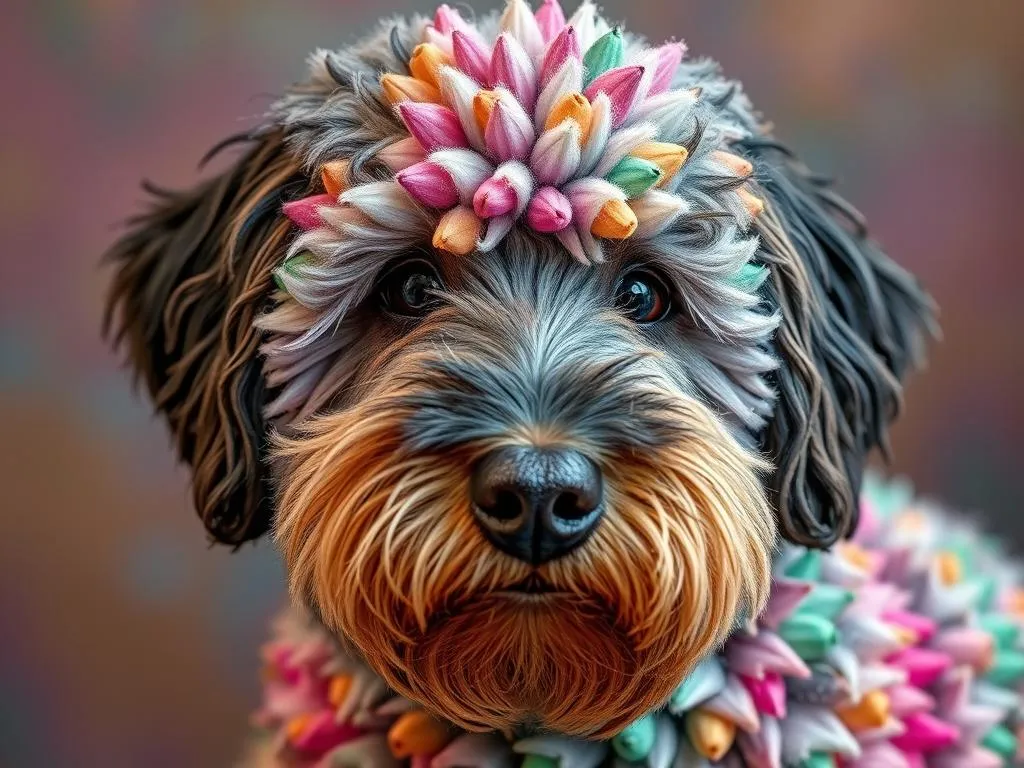
Aussiedoodles, the delightful crossbreed between an Australian Shepherd and a Poodle, have taken the dog-loving community by storm. Known for their intelligence, playful demeanor, and hypoallergenic coats, these dogs are a fantastic choice for families and individuals alike. One of the most captivating aspects of the Aussiedoodle breed is its variety of colors and patterns, which can influence a potential owner’s decision when selecting a furry companion.
When considering an Aussiedoodle, color can play a significant role in a person’s choice. Factors such as aesthetics, personality traits associated with certain colors, and even visibility in different environments can sway your decision. This guide will delve deep into the fascinating world of Aussiedoodle colors, exploring genetics, popular color patterns, and the implications of color selection in your journey to find the perfect pup.
Understanding Aussiedoodle Colors
Genetics of Color in Aussiedoodles
The colors seen in Aussiedoodles are a wonderful reflection of their parent breeds. The genetic make-up of an Aussiedoodle is a combination of the Australian Shepherd’s diverse color palette and the Poodle’s well-known solid colors. Understanding the genetics behind an Aussiedoodle’s coat can provide insights into the potential colors and patterns you may encounter.
The Australian Shepherd is renowned for its striking coat colors, including merle, tri-color, and solid colors. Meanwhile, the Poodle contributes a range of solid shades such as black, white, cream, and apricot. When these two breeds are mixed, the result is a beautiful array of colors that can vary significantly from one pup to another.
Common Color Patterns
When it comes to Aussiedoodle colors, the following patterns are commonly observed:
- Solid Colors: Dogs with a single, uniform coat color.
- Bi-color Patterns: Combinations of two distinct colors.
- Merle Patterns: A unique pattern characterized by mottled colors.
- Phantom Colors: A pattern featuring a base color with specific secondary colors.
- Sable Colors: A color pattern where the tips of the fur are darker than the base coat.
Popular Aussiedoodle Colors
Solid Colors
Solid colors in Aussiedoodles showcase the breed’s elegance and simplicity. Here are some common solid colors:
- Black: A classic and timeless choice, black Aussiedoodles often have a sleek and shiny appearance.
- White: Pure and pristine, white Aussiedoodles are striking and easy to groom.
- Brown: Ranging from dark chocolate to lighter shades, brown Aussiedoodles can have a warm and inviting look.
- Cream: Soft and gentle, cream-colored Aussiedoodles tend to have a sweet demeanor.
These colors not only enhance the dog’s appearance but also reflect certain personality traits. For instance, many owners report that their black Aussiedoodles tend to be more energetic, while cream ones often exhibit a calmer demeanor.
Bi-color Combinations
Bi-color combinations add a layer of complexity and charm to Aussiedoodle colors. Common combinations include:
- Black and White: A striking contrast that is visually appealing and classic.
- Brown and White: This combination often showcases a soft, warm look that many find endearing.
These combinations can manifest in various patterns, including patches and splashes, which further enhance their visual appeal.
Merle Patterns
The Merle pattern is one of the most sought-after and distinctive colorations in Aussiedoodles. This pattern is characterized by a mottled effect, presenting a mix of dark and light colors.
Common Merle Color Variations:
- Blue Merle: A base of grey with dark black patches, blue Merles are striking and highly sought after.
- Red Merle: Featuring a light copper base with darker red patches, red Merles are equally stunning.
While the Merle pattern is beautiful, it’s essential to note that it can come with health considerations. Merle dogs may be more susceptible to certain genetic conditions, so it’s important to choose a reputable breeder who screens for these issues.
Phantom Colors
Phantom colors are another fascinating aspect of Aussiedoodle colors. This pattern features a base color with distinctive markings of a secondary color, usually found on the eyebrows, cheeks, chest, and legs. Common phantom combinations include black with tan markings or chocolate with cream accents.
These markings not only create a unique appearance but also highlight the dog’s features beautifully.
Sable and Other Unique Colors
Sable coloring is a unique pattern that involves darker tips on a lighter base color, giving the coat a rich, multi-dimensional look. The sable pattern can range in color, showcasing various shades like black and tan or brown and gold.
In addition to sable, other unique colors may appear in Aussiedoodles, such as:
- Apricot: A warm, golden shade that can vary in intensity.
- Silver: A rare and striking hue that catches the eye.
Factors Influencing Color Selection
Personal Preference
Choosing a color for your Aussiedoodle often boils down to personal preference. Some people may be drawn to the elegance of a solid black dog, while others may prefer the unique look of a merle. Trends can also influence color choices, with certain colors becoming more popular over time.
Understanding your aesthetic preferences can help narrow down your options when selecting your new companion.
Lifestyle Considerations
Beyond aesthetics, lifestyle considerations can impact your color choice. For example, some colors may show dirt and debris more than others, which could influence your grooming routine. In addition, visibility can be an essential factor; lighter-colored dogs may be more visible in certain environments, which could be beneficial for outdoor activities.
Family dynamics and home environments can also play a role in your choice. For instance, families with children may prefer a color that is less prone to visible messes.
Breeder Insights
Choosing a reputable breeder is crucial when it comes to selecting your Aussiedoodle. Ethical breeders often have specific color patterns they focus on, which can affect your options. They also prioritize the health and temperament of their dogs over color, ensuring you find a puppy that suits your lifestyle.
When engaging with breeders, inquire about the colors they offer and their health screening practices. This can give you a clearer picture of what to expect.
Caring for Your Aussiedoodle’s Coat
Grooming Needs by Color Type
The grooming needs of an Aussiedoodle can vary based on its coat color and pattern. Here are some tips tailored to different colors:
- Solid Colors: Regular brushing is essential to maintain a healthy coat. Solid-colored Aussiedoodles may require less frequent grooming than those with more complex patterns.
- Bi-color and Merle Patterns: These coats may require more attention due to the variations in fur length and texture. Ensure you brush regularly to prevent matting, especially in areas where the colors meet.
- Phantom and Sable Colors: Pay special attention to the markings, as they can be prone to tangling. Regular grooming will help keep their coat looking its best.
Seasonal Considerations
As with all dogs, seasonal changes can affect coat maintenance. Darker colors tend to absorb more heat, which may make them less comfortable in hot weather. Conversely, lighter colors may require additional care in colder months to ensure they stay warm.
Adapting your grooming routine to seasonal needs can enhance your Aussiedoodle’s comfort. For example, during warmer months, consider shorter cuts to help keep them cool, while winter may call for more frequent brushing to manage shedding.
The Impact of Color on Adoption and Pricing
Color and Demand
The demand for certain Aussiedoodle colors can significantly influence pricing. Rare colors, such as blue merle or unique phantom combinations, may come with a higher price tag due to their popularity.
Understanding these trends can help you navigate the market when adopting your new furry friend.
Ethical Considerations
When considering an Aussiedoodle, it’s essential to prioritize ethical breeding practices. While color may be an attractive feature, it shouldn’t be the sole focus of your decision. Always consider the health and temperament of the dog over its color, as these factors will significantly impact your experience as a pet owner.
Choosing to adopt based on temperament and health ensures that you find a dog that fits seamlessly into your lifestyle, making for a happier and healthier relationship.
Conclusion
In conclusion, the world of Aussiedoodle colors is as diverse and captivating as the breed itself. While color can influence your choice, it’s important to remember that the overall well-being and temperament of the dog should be your primary focus.
By understanding the genetics, popular patterns, and the implications of color selection, you are well-prepared to find the perfect Aussiedoodle for your home. Embrace the journey, and enjoy the delightful companionship that an Aussiedoodle can bring into your life.









